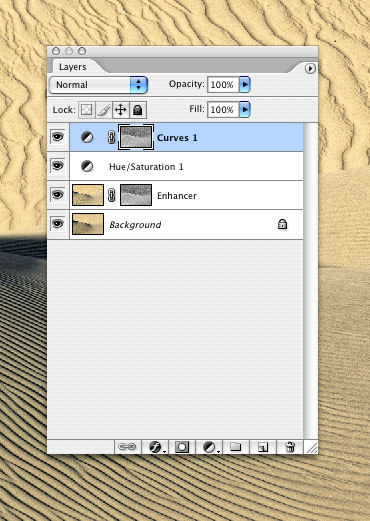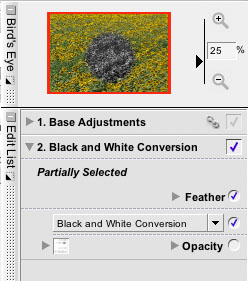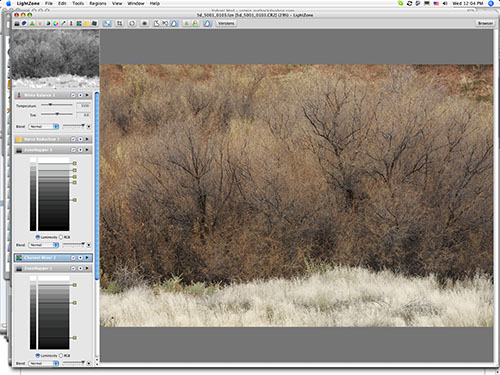All these buzzwords are often used in current articles
on imaging workflow. We try to explain them and show what is behind
all the buzz. You will learn that these are very important properties
for all imaging application but that it is not that easy to have it
all.
Nondestructive Editing
The idea behind nondestructive editing that you start with your original
image (RAW, JPG or scan) and only store the operations used to create
your final image. This has a couple of main advantages:
- You can change or fine tune any of the operations later and you
don't need to redo the whole image from scratch
- The instructions take way less disk space than the final rendered
images
- It is very easy to have different variations of operation sets
Almost all of today's RAW converters are based entirely on non-destructive
editing. Photoshop's adjustment layers also implement a way to do non-destructive
image operations. On the other end many of the more complex Photoshop
operations are destructive.
Before you complain about the way Photoshop handles images you have
to understand:
- Photoshop allows way more complex operations than most other image
editors
- Photoshop provides some sophisticated selective editing capabilities
(see below)
- Photoshop was created at times where computer resources were way
more limited than today
- Photoshop was mainly designed for designers and not only for photographers
(Adobe Lightroom is the application that is only targeted to photographers)
Selective Corrections
For more advanced imaging operations global image corrections just
are not good enough. What you need is to have is selective operations.
Selective operations are done via operation layers that can use masks
(explicit or implicit like Nik's
U-Point Technology).
Masks can be created the following ways:
- Geometric shapes (with or without a feathering option)
- Selecting color, brightness and saturation ranges
- Painting techniques
- U-Point technology which provides implicit masks based on color,
brightness and saturation ranges
In the context of a non-destructive editing workflow you may also
want to be able to edit the masks later. Photoshop's layer masks allow the most sophisticated way to create
selective image operations. Unfortunately the layer masks can easily
become destructive themselves so that editing layer masks can be hard
if even possible.
Nikon
Capture NX features Nik's U-Point technology that
allows powerful selective operations. Unfortunately the behavior
of these corrections are more intuitive and hardly controlled in
a more rigorous way.
LightZone provides
geometrical shaped regions with feathering areas to enable selective
editing. All regions can be re-edited at any time. Read our article
on how to use these regions for a powerful dodge/burn workflow. All other RAW converters that we know do not support any selective
editing operations (Apple's aperture features some clone and healing
tools that works selective though). We still hope that Adobe's Lightroom
may also feature some selective tools as well.
Layer/Operation Stacks
Once an editor supports selective editing normally the operations
get organized as layers or operation stacks (in the end kind of the
same).
Layer stacks in Photoshop 
Photoshop layer stack
Photoshop's power is only really used if you work with layers. Our
books DOP2000 and DOP3001 teach how to use layers for photography.
We could not live without them. Unfortunately many operations can easily
become destructive and also the file size grows fast (especially with
16-bit images). Blending modes (define how the layer interacts with
the base image) and opacity are a ways to even make layers more powerful.
Nikon NX operation stack

NX operations stack
Also Nikon Capture NX supports operation
(layer) stacks. The masking is done via:
- Implicit masks via U-Point technology
- Geometric shapes with limited feathering capabilities
- Painted masks
The operation layers also allow to change the opacity and support
a limited set of blending modes.
LightZone operation stack

Lightzone operation stack
LightZone supports selective regions
in a very systematic way and all tools implement them. Best you read
both our LightZone review and our dodge/burn
article.
Right now we miss selections via color
and brightness ranges in LightZone. But we were told that this will
be implemented in a future version of LightZone.
Non-Modal editing
What is a modal dialog? This is a dialog
that opens and while it is open you cannot access any other operation
inside a certain application.
- The advantages of modal dialogs/operations
is that they can be easily implemented (the software developer
knows that his application does only one thing at that moment) and
only uses
screen space once while open.
- The downside of modal dialogs is that
switching operations is slow and tedious.
Good imaging requires non-modal dialogs for all the operations that
are used most frequently because image editing is a highly iterative
process. It is iterative because different imaging properties have
influence on other properties of the image:
- Contrast and brightness
- White balance and colors
With selective imaging operations it can get even more iterative.
Most RAW converters work very much non-modal. But remember hardly
any of them implements selective image corrections. This leaves mainly
the
following three applications:
- Photoshop's adjustment layer operations are all modal
- Capture NX also uses quite a few modal operation settings dialogs
- LightZone is very much non-modal

LZ's non-modal controls
We hear that LightZone is slower than
other editing applications but this is always based on wrong comparisons.
Comparing a RAW converter that does not have selective correction is
not fair as they solve a much more simple problem. Then if you compare
LightZone to other editors that feature selective operations you will
find that the practical use on LightZone is actually very fast and
the use of non-modal editing operations is the secret. Overall we need
less time in LightZone to do quite sophisticated corrections.
There is no doubt that Photoshop allows
way more ways to correct images but you will find that the tools LightZone
offers go a long way and the new LightZone RAW engine even makes it
one of the top editors for nondestructive and selective RAW editing.
Conclusion
In the end we want it all:
- Non-destructive
- Non-Modal
- Selective
- Working with layer stacks
The design of such applications is by no means trivial and you
hardly can have it all. Think that these applications need to reprocess
the whole layer stack for every operation you perform (e.g. if you
change a bottom layer).
LightZone is a major advance into
the right direction. LightZone maybe not
a replacement
for Photoshop
in
all
areas. Working with an application that allows non-modal editing
gives you more freedom to experiment with your images.
|